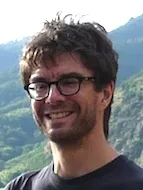Coding for the coded side information problem
Claudio Weidmann
ETIS Laboratory, ENSEA - CNRS - Université Cergy-Pontoise (France)
Abstract:
We study a scheme for the binary coded side information problem. The source is encoded to a syndrome using an LDPC matrix, while the side information (SI) is compressed with a convolutional quantizer. We propose an iterative decoding algorithm that projects intermediate estimates of the source word onto the Voronoi cell corresponding to the SI quantization index, instead of just using the quantizer output as SI representation. The hope is that this projection brings the representative SI word closer to the source word, and thus accelerates iterative decoding. This intuition is confirmed by simulations. In fact, we show that the decoder is amenable to numerical density evolution and thus to LDPC code optimization. First results display significant gains compared to off-the-shelf codes.
The second part of this talk will take a closer look at the characterization of the Voronoi cell of a convolutional code, which is a critical aspect of the proposed scheme. This leads to insights on its limitations. (joint work with Anne Savard)
Biography:
Claudio Weidmann received the Dipl. El.-Ing. degree from ETH Zurich in 1993, and the Docteur ès Sciences degree from EPF Lausanne in 2000, both in electrical engineering. Since 2010, he is an Associate Professor at Université Cergy-Pontoise, France, and a researcher at ETIS. He holds a CNRS Higher Education Chair in telecommunications and information theory. From 1996 to 2001 he was a Research Assistant and a Post-Doc at EPF Lausanne. In 2002, he was a Post-Doc at IRISA/INRIA Rennes, France.
From 2003 to 2009 he was a senior researcher at the Telecommunications Research Center Vienna (FTW), Austria. In 2009/10 he was with Vienna University of Technology, Austria, and the Laboratoire des Signaux et Systèmes (L2S), France. His research interests include applied information theory and signal processing, in particular lossy
(distributed) source coding and joint source-channel coding and decoding.
